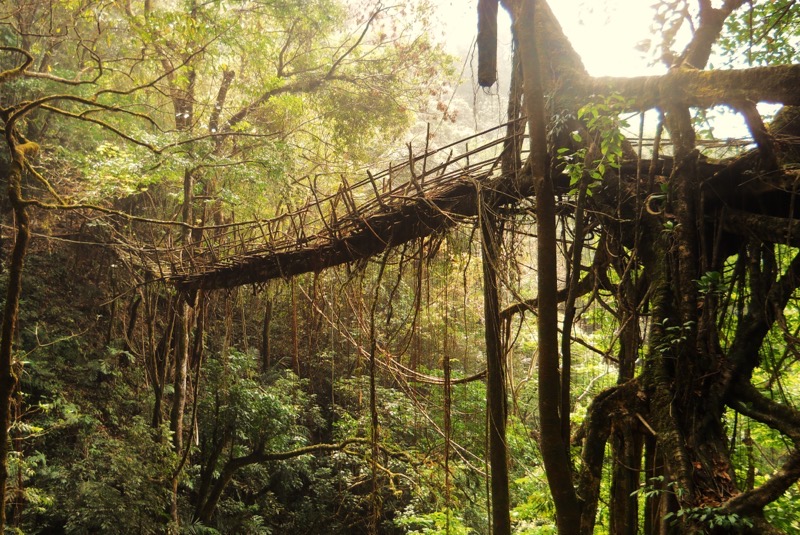Meghalaya, ‘the abode of the clouds,’ receives the highest rainfall in India. In fact, it is popularly known as the ‘wettest place in the world.’ In such a climate, infrastructure made of steel can quickly rust. Mawsynram, a place with the most rainfall, receives thirty-nine feet of annual rain, enough to submerge a three-storeyed building. With its running rivers, the wood bridges may decay and degrade fast, or worse, be washed away by a single surge of flow.
The people from the Khasi and Jaintia tribes have found a solution, a technical wonder, that even modern architects couldn’t. Connecting the land cut by the gushing streams of the rainy state are the living root bridges. As the name suggests, living root bridges are alive, constructed from the aerial roots of growing Indian rubber trees, the Ficus Elastica.
‘It’s really incredible how strong they are, and they are growing stronger over time. They are anchored to the earth but don’t have any negative impact on the environment – they are part of it,’ CNN reports Ferdinand Ludwig, the author of a study exploring this architectural marvel. According to researchers, these Meghalaya bridges, which can span up to 50 metres and survive for hundreds of years, might help us counter rising global temperatures connected with the problem of climate change.
The people living in northeast Indian highlands have a close bond with nature. Before modern construction methods, they invented this method of constructing living root bridges to transcend rapid streams and connect remote towns. It allows farmers to reach their lands and sustain their agricultural practices, a major industry in their economy. Locally, these structures are called jing kieng jri. ‘Our ancestors were so clever,’ says Shailinda Syiemlieh, a local from the hamlet of Tryna. ‘When they couldn’t cross rivers, they made Jingkieng Jri – the living root bridges,’ she told BBC.
Meghalaya has hundreds of living root bridges across the state. Some of them are over 600 years old. Ludwig found that the bridges are a result of the efforts of various members of the community. People from different villages collaborate to create the structure and maintain it through generations. ‘This gives hope that this tradition can survive because it is on many shoulders,’ he told CNN.
The construction methods vary depending on local circumstances and the required span of the bridge. However, the process generally starts with people planting a sapling along each side of a river. Once the roots emerge from the earth (as they are aerial roots), they are woven around a temporary scaffolding of bamboo or palm stems and guided toward the other side. The roots are planted again in the soil on the opposite side.
The process spans over 15-30 years. The trees first grow enormous roots for approximately a decade. Then, the mature trees produce secondary aerial roots from higher up. Multiple roots stem out on their own. The roots have a considerable amount of flexibility and create complex structures where they sometimes merge, adding to the strength of the design. The merging or the fusing of roots is called inosculation.
Damp weather and the activity of people passing through it help to compress the soil over time. When combined with inosculation, it results in a mature bridge, which can withstand the weight of 35 people to 50 people. Sometimes, the villagers put stones to fill the gaps between the roots.
Unlike the modern infrastructure of the cities made with metal, lumber, and concrete, the living root bridges prove to be more robust and sustainable. The Meghalayan structures get stronger with time as the trees grow and the roots develop across the river. ‘It’s an ongoing process of growth, decay and regrowth, and it’s a very inspiring example of regenerative architecture,’ Ludwig added.
The living root bridges resist the periodic flash floods and storms of the region. The construction is not only low-cost but also a long-term solution for connecting isolated communities and towns in the hills. Some bridges have gained popularity, drawing hordes of visitors wishing to observe indigenous climatic resistance models. However, many old ones are inactive and in danger of being cut down by lumberjacks.
Researchers discovered that living root bridges have a restorative impact on their surroundings. Scientists anticipate that this concept of using roots for construction would aid contemporary cities in combating climate change. Not only does it abstain from using any construction material, but the living root bridges also absorb the devious greenhouse gas carbon dioxide. They aid in soil stabilisation and the prevention of landslides.
Ludwig, who also teaches green technologies in landscape architecture at the Technical University of Munich, says that living root bridges prevent soil erosion by anchoring soil structure, unlike traditional bridges, which may break soil layers. Using trees for architecture also provides habitats for other flora and fauna, such as moss, squirrels, insects, etc.
According to the professor, living root bridges can green up buildings and places everywhere. Ludwig’s team started constructing a European summer kitchen roof using a pavilion of trees inspired by Meghalayan structures. The London plane tree or Platanus hispanica simulate the procedure of Ficus elastica.
‘We are learning how to react to plant growth in Europe: humans plant trees, trees grow, humans react, trees react again. This way of interacting with nature is essential for a sustainable and regenerative future,’ said Ludwig in an interview with BBC.
Ludwig intends to adopt components of indigenous engineering and apply them to urban contexts. He thinks that living architecture can help improve the outward well-being of city dwellers. Incorporating trees into buildings, bridges, and parks will restore nature in congested places.
Although barely developed outside Meghalaya, architecture motivated by living root bridges shows the potential to play a critical role in cities, benefiting urban air, soil, and wildlife. It could be a sustainable step in the human battle against climate change.
-30-
Copyright©Madras Courier, All Rights Reserved. You may share using our article tools. Please don't cut articles from madrascourier.com and redistribute by email, post to the web, mobile phone or social media.Please send in your feed back and comments to [email protected]











